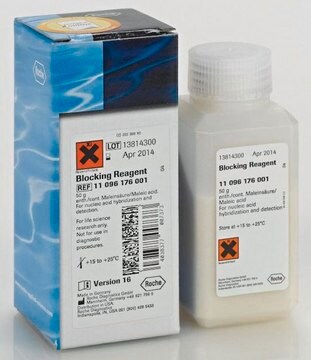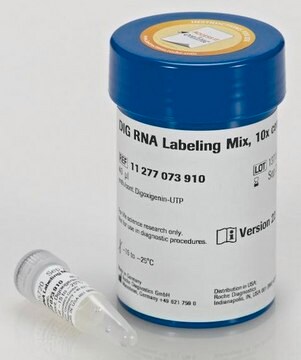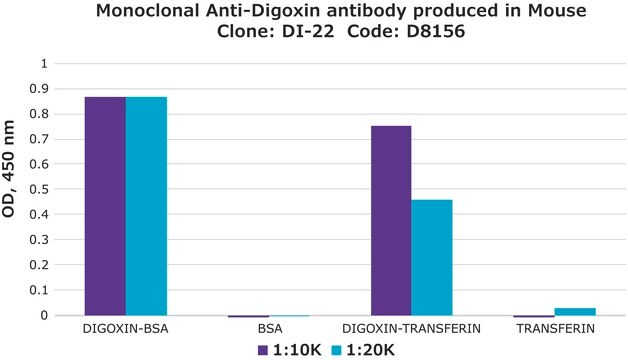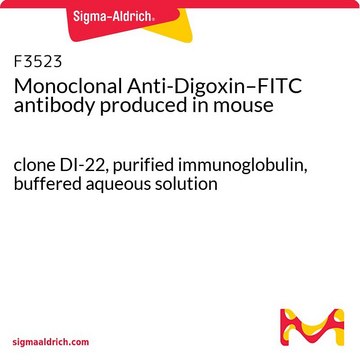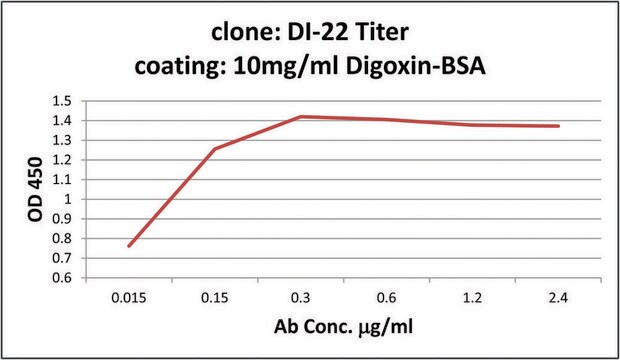11207733910
Roche
Anti-Digoxigenin-POD, Fab fragments
from sheep
Sinônimo(s):
anti-digoxigenin, digoxigenin
About This Item
Produtos recomendados
fonte biológica
sheep
Nível de qualidade
conjugado
peroxidase conjugate
forma do anticorpo
F(ab′)2 fragment of affinity isolated antibody
tipo de produto de anticorpo
primary antibodies
clone
polyclonal
Formulário
lyophilized (clear, brown solution after reconstitution)
embalagem
pkg of 150 U
fabricante/nome comercial
Roche
temperatura de armazenamento
2-8°C
Descrição geral
Especificidade
Aplicação
- Dot blot
- ELISA
- Immunohistocytochemistry
- In situ hybridization
- Western blot
Nota de preparo
Working concentration: Working concentration of conjugate will depend on the application and substrate. The following concentrations should be taken as a guideline: Dot blot: 150 mU/ml
- ELISA: 50 to 150 mU/ml
- Immunohistocytochemistry: 250 to 500 mU/ml
- In situ hybridization: 1.5 to 7.5 U/ml
- Southern blot: 150 mU/ml
- Western blot: 250 to 500 mU/ml
Working solution: 100 mM Tris-HCl, 150 mM NaCl, pH 7.5.
1% Blocking reagent (w/v), 1 to 5% heat inactivated fetal calf serum (v/v) or sheep normal serum can be used for reduction of unspecific binding.
Reconstituição
Outras notas
Não está encontrando o produto certo?
Experimente o nosso Ferramenta de seleção de produtos.
Palavra indicadora
Warning
Frases de perigo
Declarações de precaução
Classificações de perigo
Skin Sens. 1
Código de classe de armazenamento
11 - Combustible Solids
Classe de risco de água (WGK)
WGK 1
Ponto de fulgor (°F)
does not flash
Ponto de fulgor (°C)
does not flash
Escolha uma das versões mais recentes:
Já possui este produto?
Encontre a documentação dos produtos que você adquiriu recentemente na biblioteca de documentos.
Os clientes também visualizaram
Artigos
Digoxigenin (DIG) labeling methods and kits for DNA and RNA DIG probes, random primed DNA labeling, nick translation labeling, 5’ and 3’ oligonucleotide end-labeling.
Nossa equipe de cientistas tem experiência em todas as áreas de pesquisa, incluindo Life Sciences, ciência de materiais, síntese química, cromatografia, química analítica e muitas outras.
Entre em contato com a assistência técnica
